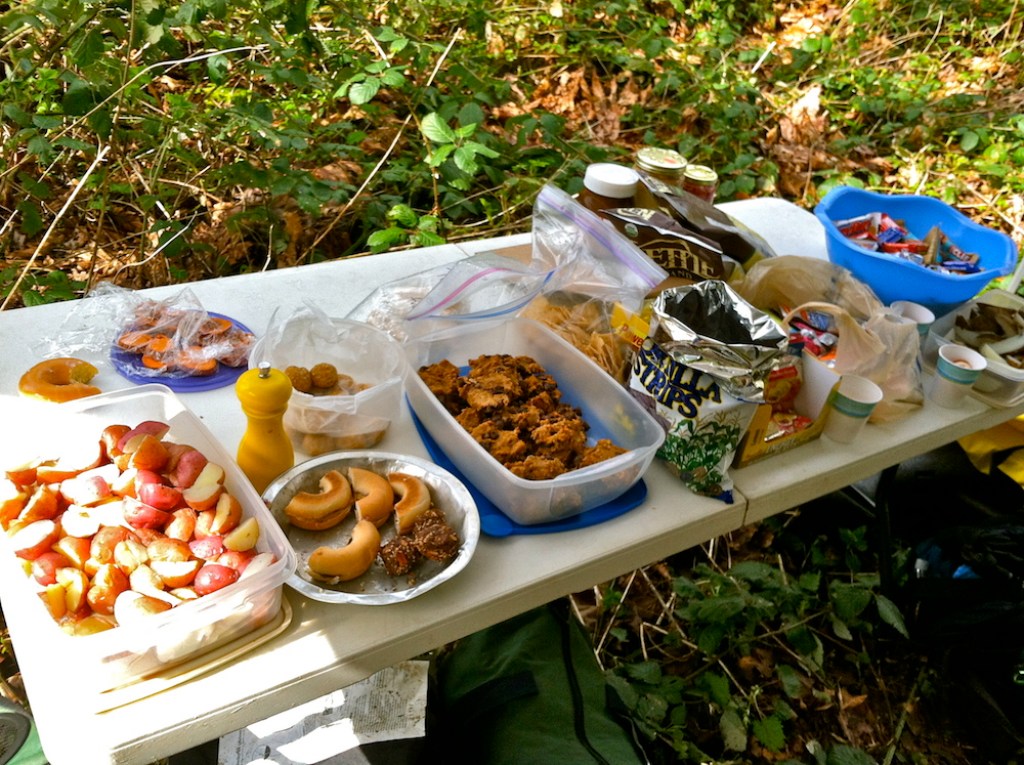Avoiding hitting the wall by honing your eating strategy with these pro tips.
In Christopher McDougall’s 2009 bestseller, Born to Run, he quoted sports nutritionist and accomplished ultrarunner Sunny Blende with an apt description of trail and ultra races as “just eating and drinking contests, with a little exercise and scenery thrown in.”
Indeed, few skills are as important for the long-distance trail runner to develop as mastering the art of eating on the run. Without ongoing fuel to help the body replenish its glycogen—the energy it burns off while exercising—you’re destined for the dreaded runner’s “bonk.” Here’s how to fuel your long runs, according to t he experts.
Find Easy-to-Digest Foods
“What you eat for breakfast, lunch, and dinner is vastly different than the simple carbohydrates that are best during running,” says Dr. Stephanie Howe Violett, sports nutritionist and ultrarunner for The North Face. In her experience, energy gels and chews work best for most runners, given their ideal carbohydrate composition for absorption across the gut and immediate energy availability.
Even if you’ve never been diagnosed with a specific food sensitivity or allergy, try avoiding common irritants such as dairy, gluten, and soy. Also beware of high-fiber foods (including excessive amounts of fruit, grains, and other complex carbohydrates) immediately before or during a run, which can trigger problems in sensitive stomachs.
Explore a Cornucopia of Options
Many wonderful, portable foods exist for trail runners, ranging from energy gels and bars to pureed baby-food pouches to individual squeeze packets of flavored nut butters. For longer runs—especially more mountainous trails that include power hiking and a slower overall pace—some runners enjoy incorporating some protein and fat as well. Popular choices are beef jerky, granola bars, avocado-tortilla wraps, and peanut-butter-and-jelly sandwiches.

A typical trail race aid station | Photo: Yitka Winn
“I recommend trail runners take whatever works for their body and is palatable for them, whether that’s gels and chomps or nut butter and sweet potatoes,” says Maria Dalzot, registered dietitian and trail and mountain runner for La Sportiva. “This is not the time to worry about getting in all your vitamins, minerals, and macronutrients. It is about getting from point A to point B energized and feeling good.”
Aside from specially formulated products, also consider options such as bananas, avocados, trail mix, boiled and salted sweet potatoes, dried fruit or fruit leathers, or any other calorically dense snack foods.
Finally, don’t be afraid to get creative in the kitchen. Explore making your own on-the-trail treats, which can include everything from rice cakes to granola bars to homemade energy chews. (Feed Zone Portables is one of my personal favorite recipe books.)
Drink Up
The number-one fueling mistake that Patagonia ultrarunner, nutrition coach, and race director Keira Henninger says she sees trail runners making is not drinking enough water. Staying well-hydrated is key to aiding your digestive system, so drink water consistently, especially if you’re sweating heavily. Be sure to wash down energy foods or gels with water, too—which both aids in digestion and helps rinse some of the sugar off your teeth!
If you struggle with eating solid foods in the middle of a run, there are also a number of drink mixes you can stir into a handheld water bottle to help you replenish calories. (Henninger’s favorite is CarboPro.) Many are a simple carbohydrate and electrolyte mix, though some also incorporate protein or even fat.
Be Strategic About When You Eat
Don’t wait for hunger to strike. Rather, be proactive about taking in consistent fuel. Howe recommends runners aim to consume between 200 and 300 calories per hour during a race. “In training, you want to try that much during key long runs,” she says, “but it’s OK not to get that much each long run. I think 100 to 200 calories per hour is a good minimum.”
It’s also important to be strategic about when you eat so as to maximize the chances of things going down smoothly. I speak from experience; as tempting as that bowl of peanut M&Ms may look at the top-of-the-climb aid station you just worked so hard to reach, wolfing a lot of food before a long, jostling downhill can be a recipe for gastrointestinal distress. If possible, eat toward the bottom or middle of big climbs, rather than at the top, or on flatter sections.
Don’t be afraid to stop and walk for 30 to 60 seconds to digest some calories. This can be easier on the stomach than trying to wolf food down while literally running.
Practice Makes Perfect
Even if trying to eat “on the run” does not sit well with your stomach the first time you try it, don’t give up. Just like any other aspect of training, the more you practice eating on long runs, the more your body will adapt to doing so.
“You can train the gut just like a muscle, so it is important to practice fueling during your long training runs,” says Dalzot. And the more you experiment in training with different types of food and fuel, the more you’ll be able to hone in on what works best for your body.
One final reminder from Henninger: “Don’t ever try anything new on race day.”
